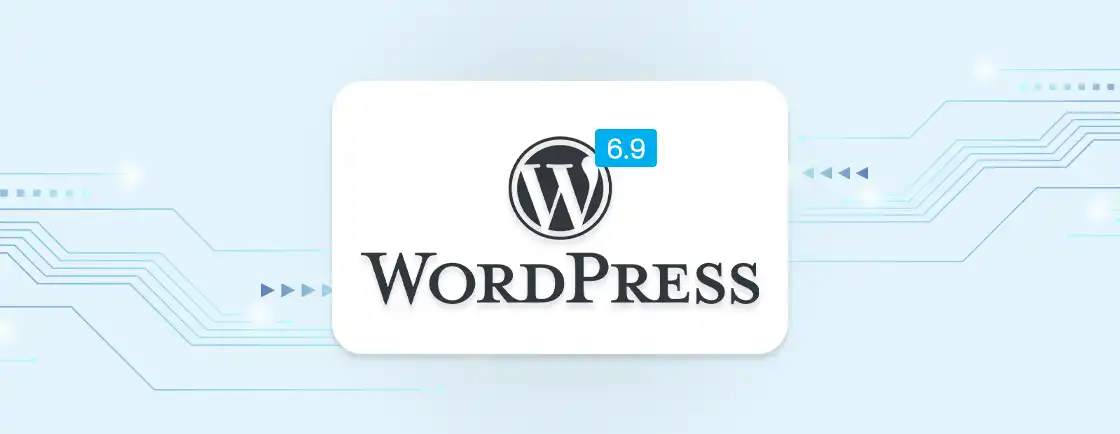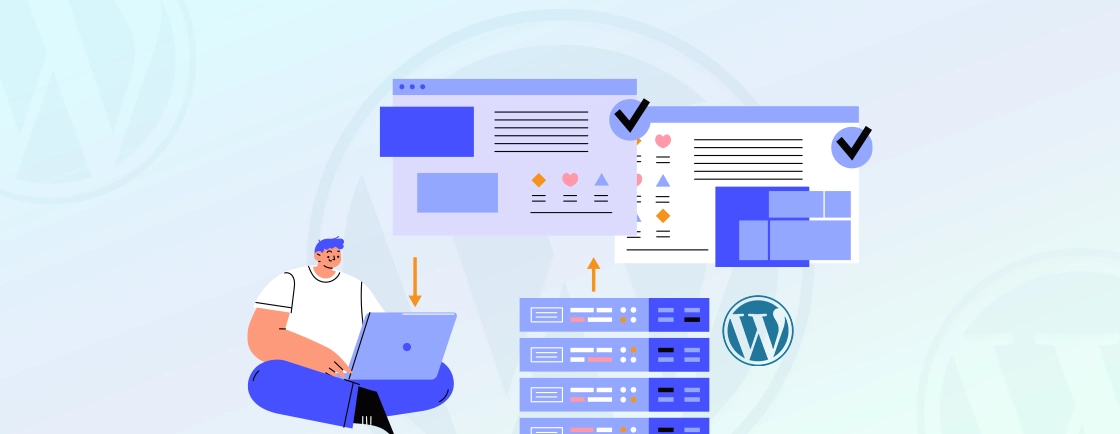Table of Contents
One of the biggest strengths of WordPress is its customizability, and it’s primarily fueled by the themes. This platform has over 13k free themes, along with a number of paid, premium ones found in third-party marketplaces.
Whether you are launching a blog or building an e-commerce store, installing a theme correctly is important. A single misstep can break your site’s layout or even cause security risks.
So through this blog, we’ll see how to install a WordPress theme–using the WordPress repository, custom uploads, or through FTP. But first, let’s discuss what the theme is.
What is a WordPress Theme?
A WordPress theme is a group of templates, stylesheets, and code that determines the design of the website. With it, you customize everything from layout and color scheme to typography and widget placement. All that without needing to write a single line of code.
As mentioned earlier, there are thousands of free and paid (premium) themes available in the official repository as well as third-party marketplaces. Themes build upon your foundation WordPress installation, so ensuring your core setup is solid enables you to make the most of any theme you choose.
A well-chosen theme ensures a professional design, responsive performance, and seamless user experience. However, not all themes are equal. Some prioritize aesthetics, while others focus on speed, SEO, or eCommerce compatibility.
So, how do you choose the right theme? Let’s find out.
How to Choose the Best WordPress Theme?
A theme impacts the WordPress site’s design, speed, and user experience. And, it is one of the most crucial aspects of the WordPress SEO checklist, impacting the search visibility. So you need to choose the theme carefully. Here are a few key factors to consider:
Website’s Purpose
Your theme should align with your site’s core function. The theme will be different based on whether it’s for a blog, portfolio, online store, or business website.
A minimalist theme will work well for writers and bloggers. But an eCommerce website will need a theme with WooCommerce support with all eStore-focused features. Choose a design that enhances your content, not distracts from it.
Performance & Speed
A slow-loading theme drives visitors away. Go for lightweight, well-coded themes with minimal bloat. Check benchmarks (like GTmetrix scores) or look for themes optimized for speed. Avoid excessive animations and bulky scripts that drag down performance.
Mobile Responsiveness
Over half of web traffic comes from mobile devices. Ensure your theme automatically adapts to phones and tablets by testing its demo on different screens. Google also prioritizes mobile-friendly sites in search rankings.
Customization Options
A flexible theme saves time and coding hassle. Look for built-in customization features like drag-and-drop builders, color schemes, and font controls. One of the key differentiators between free and paid themes is the level of customizability. As in, premium themes often offer deeper customization than free ones.
Reviews, Ratings, & Support
Check user feedback to spot recurring issues like bugs or poor support. A theme with high ratings and active developer responses is more reliable. Avoid abandoned themes with no recent updates.
Security
Poorly coded themes can expose your site to vulnerabilities. Stick to trusted sources like the WordPress repository or reputable developers. Avoid nulled (pirated) themes—they often contain malware. Regular updates are a must for security patches.
Before Installing the WordPress Theme
Before we move on to installing the theme, there are a few essentials you need to take care of. They ensure a smooth design and functionality setup. Let’s look at them one by one.
- Backup Your Website: Use a plugin like UpdraftPlus or your hosting provider’s built-in tools to back up your WordPress website and save its data.
- Check Theme Requirements: Verify that the theme supports your WordPress version and is compatible with essential plugins.
- Review Demo & Documentation: Explore the theme’s demo and read its documentation to understand customization options.
- Test in a Staging Environment: If possible, install the theme on a WordPress staging site first to avoid disrupting your live website.
Taking these precautions minimizes risks and helps you avoid common setup issues.
How to Install a WordPress Theme? (Through the Official Directory)
The most direct, user-friendly, and easiest way to install a theme is through the official WordPress directory. Here’s a step-by-step guide:
Step 1: Log into your WordPress admin dashboard. Go to yourdomain.com/wp-admin and enter your credentials to access it.
Step 2: Go to Appearance → Themes and click ‘Add New’.
Step 3: Next, browse or search for a theme.
You can use the search bar to find a specific theme by name (e.g., “Astra,” “OceanWP”). Alternatively, you can browse featured, popular, or latest themes using the filters.
There’s also a way to preview the theme by hovering over it or clicking ‘Details & Preview’. It’ll help explore the design and see if it fits your site’s purpose.
Step 4: Once you’ve chosen a theme, click ‘Install’ (the button will appear when you hover over the theme).
Step 5: After installation, click ‘Activate’ to apply it to your site.
Step 6 (optional): Go to Appearance → Customize to modify colors, layouts, and other settings. Some themes include starter templates for quick setup.
If the free themes don’t suffice you, premium (paid) ones are available in third-party marketplaces. You’ll need to upload one through the dashboard.
How to Install a WordPress Theme? (Using the Upload Method)
If you’ve purchased a premium theme or downloaded a third-party WordPress theme, you’ll need to install it manually. Here’s how you do it.
Step 1: Download the theme ZIP file. If you bought a premium theme (e.g., from ThemeForest), download the installable ZIP file (not the “full package” or “source files”).
Avoid modifying or unzipping the file—WordPress needs it in its original compressed format.
Step 2: Log in to your WordPress admin dashboard. Go to yourdomain.com/wp-admin and enter your credentials to access it.
Step 3: Go to Appearance → Themes and click ‘Add New’. Then, select ‘Upload Theme’ (next to the “Add Themes” title).
Step 4: Click ‘Choose File’ and upload the theme’s ZIP folder from your computer.
Step 5: Press ‘Install Now’. If successful, you’ll see: “Theme installed successfully.“.
Step 6: Click ‘Activate’ to apply it to your site. Some premium themes may prompt you to install required plugins—follow the setup wizard if applicable.
After the theme is activated and installed, configure its settings and import demo content (if available).
How to Install a WordPress Theme? (Via FTP Client)
There’s a chance you encounter problematic server uploads in case of a larger theme. Then installing the theme via FTP might be more reliable. Here’s how you go for it.
Step 1: Download the theme ZIP file from a trusted source (like ThemeForest or developer’s official site).
Step 2: Extract the ZIP file on your computer—you should see a folder (e.g., astra-theme) containing WordPress theme files (like style.css).
Step 3: Connect to your website via FTP. Open the FTP client and enter the credentials (you might find them in the hosting cPanel or SFTP settings).
- Host: yourdomain.com or server IP
- Username: FTP/login username
- Password: FTP/login password
- Port: 21 (FTP) or 22 (SFTP—more secure)
Step 4: Click ‘Connect’ to access your server files.
Step 5: Navigate to /wp-content/themes/ folder. This is where all WordPress themes are stored.
Step 6: Drag the folder from your computer into the /themes/ directory. Wait for the transfer to complete (larger themes may take a few minutes).
For FTP-based theme uploads, you’ll want to use a reliable FTP client. Check out best FTP clients for WordPress to help you select the most efficient option for your needs.
Step 7: Go to your WordPress Dashboard → Appearance → Themes.
Step 8: Locate the uploaded theme and click “Activate” to apply it to your site.
This method may come in handy if you need direct access to the theme for customization. Remember to always use SFTP (encrypted) over basic FTP to protect sensitive data. If you still encounter issues with theme installation or customization, you can hire WordPress developers who can troubleshoot the problem and tailor the theme to match your vision.
Best Practices for WordPress Themes
Although it’s pretty straightforward to download and install a WordPress theme, you need to follow some industry-best practices. They will help ensure smooth functioning, consistent design, and outstanding performance.
Let’s discuss the best practices for WordPress theme installation.
#1. Choose a Reputable Theme
Opt for themes from reliable sources such as the official WordPress Theme Directory or well-known theme developers. These themes will likely be regularly updated, secure, and compliant with WordPress standards.
#2. Regularly Update the Theme
One of the first and most significant practices is the regular updating of this CMS. Every new version brings bug fixes, security enhancements, and new features.
#3. Optimized for Speed
Prioritize themes that are optimized for speed and performance. A fast-loading website improves user satisfaction and SEO rankings.
#4. Security
Prioritize themes with a strong security track record. Themes from reputable sources are more likely to be audited for security vulnerabilities.
#5. Cross-Browser Compatibility
Ensure the theme works well on different web browsers like Chrome, Firefox, Safari, and Edge to reach a wider audience.
#6. Responsive Design
Select a theme with a responsive web design that adapts to various screen sizes and devices. A mobile-friendly website is crucial for a positive user experience and search engine rankings.
#7. Use Child Themes for Customizations
If you want to customize your theme, use a child theme instead of modifying the parent theme directly. That prevents your customizations from being lost during theme updates.
#8. Translation and Multilingual Support
If you have an international audience, choose a theme that supports translation and multilingual plugins for easy localization.
#9. SEO-friendly
Look for themes with built-in SEO features or compatibility with popular SEO plugins to help optimize your website for search engines.
#10. Support and Documentation
Select a theme that offers good support from the developer and has comprehensive documentation. That ensures you can seek assistance and find answers to your questions easily.
#11. Test Theme Demos
Before finalizing a theme, test its demo version to see how it looks and functions. It helps you get a better idea of how it will fit your website’s needs.
It’s also important to make sure the WordPress theme aligns with the website’s goals and enhances its aesthetics for outstanding UX.
Let’s Summarize
The basis of a WordPress website’s design and functionality is the theme. So you need to choose and install them carefully. You can opt for a free theme from the directory, upload a premium one, or use FTP for manual installation.
Remember to:
- Backup your site before making changes.
- Test new themes in a staging environment if possible.
- Keep your theme updated for security and performance.
Have questions or run into issues? Then connect with our team offering custom WordPress development services to get expert guidance and tailored solutions for your website today!
FAQs Related to WordPress Theme Installation
Can I install multiple WordPress themes at once?
Yes, you can install multiple themes, but only one can be active at a time. Keeping unused themes installed is fine, but too many may slow down updates.
Will changing my theme delete my content?
No, switching themes does not affect posts, pages, or media. However, some widgets, menus, or customizations may need reconfiguration.
How often should I update my theme?
Update as soon as new versions are released to fix bugs, improve security, and ensure compatibility. Always back up first.
Can I switch themes without losing my homepage settings?
Some themes save settings (like custom homepages), but others reset. Use a page builder or export/import settings if needed.
Are free WordPress themes safe?
Most free themes in the official WordPress directory are safe. Avoid downloading from untrusted sites—they may contain malware.
Create with WordPress CMS
Build flexible and scalable websites using WordPress's powerful content management system.





